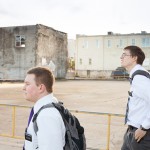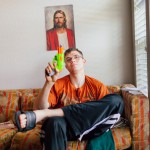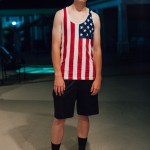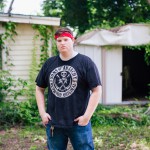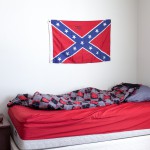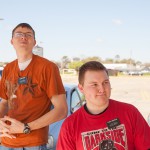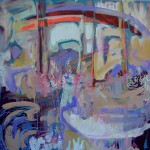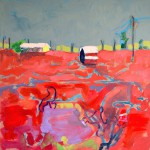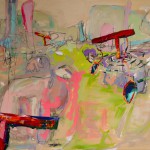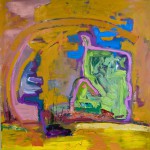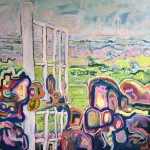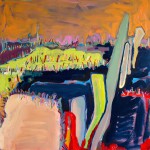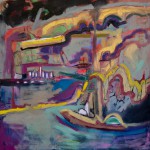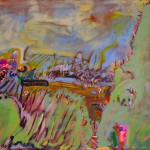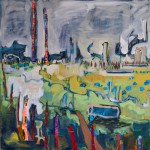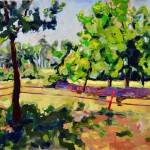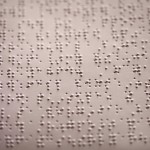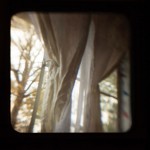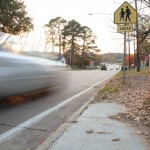Third Year MFA Student Work
Marcus Journey
Missionary Boyhood as an Elder
Last year I crossed paths with Mormon missionaries who live in my apartment complex. Having been raised in the Mormon Church, I expressed interest in documenting their ministry in an effort to show a private dimension of their lives that is unknown to many. We agreed I would be allowed to photograph what they do in various neighborhoods in exchange for giving them pizza and rides around town. At eighteen years old, Mormon Elders are still developing physically and spiritually while working to share their gospel in a culture far from home. Serving for a period of two years, these young men postpone activities that others their age experience, such as college, dating, television, social media, and time with family. And they encounter the same growing pains as other young people traveling far from home to attend college or serve in the military.
This collection of photographs, taken in Shreveport, Louisiana, reveals the transitory conditions in which missionaries live as they embed themselves in a place for six weeks to six months, then are transferred by the Church to a new city just as they are becoming familiar with the area and its people. The process of getting to know strangers and one another repeats as the Elders move elsewhere and a new group takes their place in the neighborhood, as well as in my series.
Adrianna Speer
Artist Statement
Memorable Places
Driving across Louisiana was a normal part of my experience of viewing landscapes as a child. While being fastened into the car on a rural highway I can remember often times being fascinated with the long, open stretches of land beyond the car window. I felt and still do feel a longing to explore and experience everything on the other side of the glass. My admiration for nature, recollection of memory, and passion for the process of painting influence the making of my work. While painting I think about how a landscape is viewed and experienced. Specifically I recall my own observations and encounters as a child juxtaposed to the present as an adult. The absence of the figure is intentional furthering my sense of longing to excavate and discover.
I draw and paint from photographs and memories I have made of the land. Having several reference sources allows me to work in flux taking bits of information from all my sources to make a whole painting. Photographs are used to facilitate memory and composition; they are the initial starting point for my paintings. When working from memory I get a feel of the place again, and it sets the mood for the color palette and development of my painting. I work out my composition by improvisation. Paint application and color together mix and weave in and out of charcoal drawings on the painting’s surface. The content of my work becomes an open interpretation. Instead the object’s form is suggested by outlines, contours and dried acrylic paint collaged to the painting’s surface.
As I work on the painting my choices become more spontaneous and experimental. I have a strong desire for the physical process of painting. Mixing color, paint application, collage, charcoal drawings are all very tactile experiences for me. The play between my choice of materials and the development of each painting speaks to the lyrical history of Abstract Expressionism; they create a meandering compositional rhythm and function as a mode of organization.
Second Year MFA Student Work
Jonathan Clayton
I know what it is like to be an outsider. My twelve years living in China allowed me the opportunity to experience life as one. I can understand what it like to live on the exterior of society with people staring, pointing and saying foreigner loudly and unabashedly as I walked down the streets of Beijing, the fact I was alien was never lost on me. My re-emersion to American life began a little over a year ago and I still cannot help feeling like I am still somewhere in between indigenous and foreign. It is in this light that I began to notice others that seem to orbit on the outskirts of society, not quite understood, not quite accepted.
Whether I am depicting the lives of the childless, impoverished, forgotten elderly living in charity run retirement homes in Henan, China; documenting the struggles those with Chronic Fatigue Syndrome face, or documenting what it is like living with blindness, I want to document the journeys societal unknowns experience as they live their lives. I desire to broaden understanding through photographic passages that make us better by taking them.

